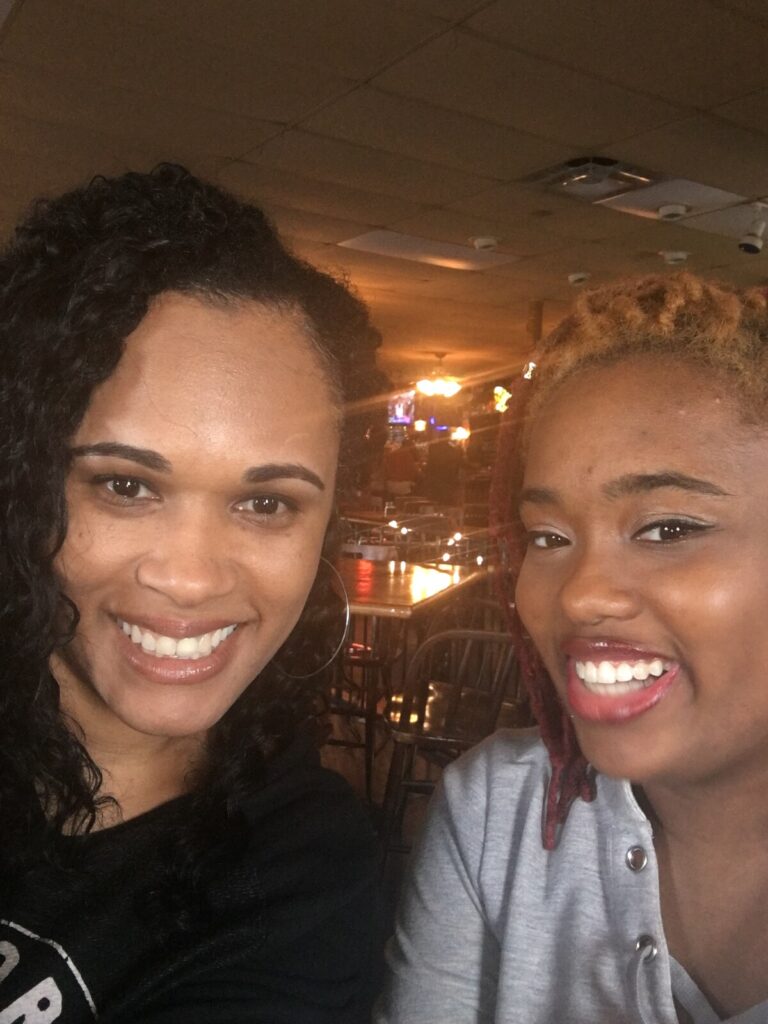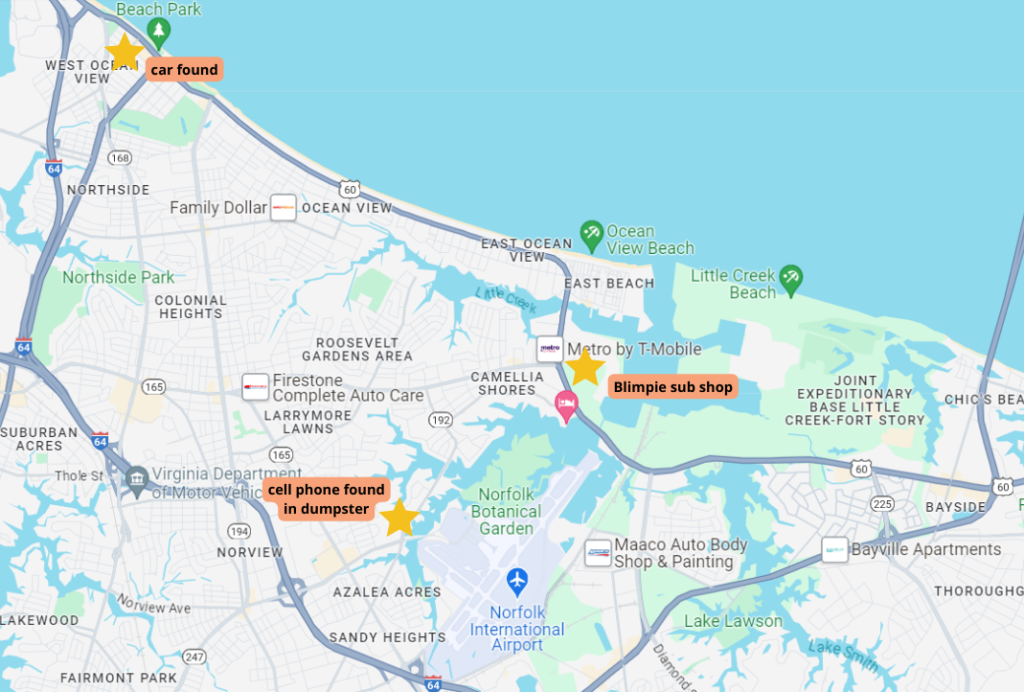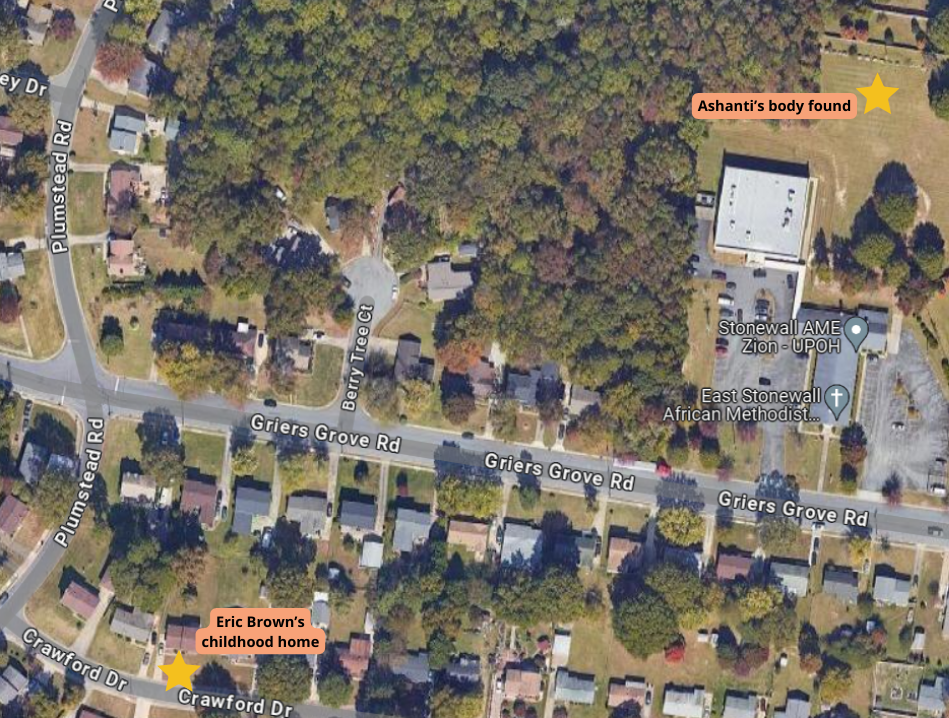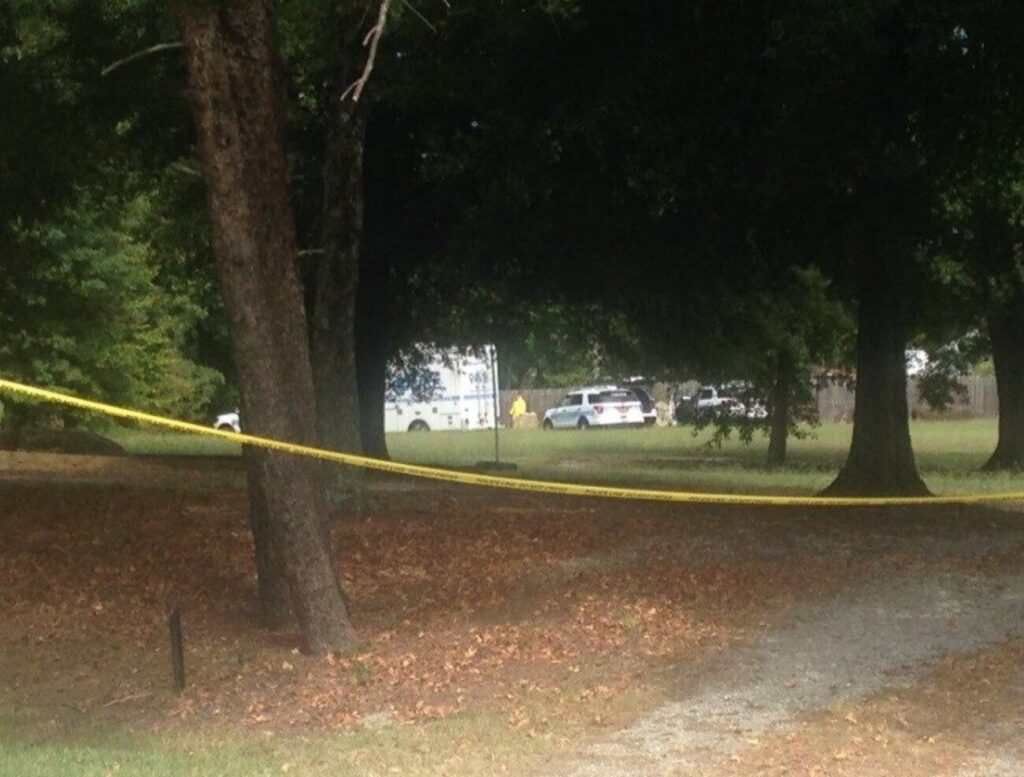When a young woman vanishes from a military base, her family goes to great lengths to find the truth and fight for justice. What happened to Ashanti?
Episode Media






Episode Sources
- Ashanti Billie Obituary (1998 – 2017)
- Virginia Beach police searching for missing 19-year-old woman; disappeared under “suspicious circumstances”
- Missing 19-year-old woman last seen at apartment complex
- Family and friends can’t figure out what happened to missing Virginia Beach woman
- Missing Virginia Beach woman’s car found in Ocean View
- “It’s been hell”: Missing 19-year-old Virginia Beach woman has been gone a week
- FBI takes over investigation of missing Virginia Beach 19-year-old, offers $10K reward
- FBI: $10,000 reward offered for information leading to arrest in Norfolk State student’s death
- Search for missing college student underway in Virginia Beach
- FBI releases video of Virginia Beach teen’s car being driven on base the day she went missing
- FBI releases video of Ashanti Billie’s car entering JEB Little Creek-Fort Story
- Blimpie sandwich company adds $10K to reward for missing Virginia Beach 19-year-old
- Where is Ashanti Billie? Relatives, strangers search for clues about Virginia Beach 19-year-old’s disappearance
- Body found in Charlotte believed to be that of missing Virginia Beach 19-year-old Ashanti Billie
- Missing college student’s family awaits identification of a body
- FBI confirms body found in Charlotte is missing Virginia Beach 19-year-old Ashanti Billie
- Missing Virginia teen found dead at North Carolina church
- Police confirm body found behind church is missing Virginia Beach, Va., teen
- FBI confirms body found in North Carolina is missing Virginia Beach woman; Parents make statement
- Friends and family remember Ashanti Billie
- Ashanti Billie’s parents have created a scholarship in her honor at Art Institute of Virginia Beach
- Funeral for Ashanti Billie to take place in Maryland
- Ashanti Billie funeral: Family, friends say goodbye to murdered Prince George’s County teen
- FBI seeks videos of Ashanti Billie’s car between Hampton Roads and Charlotte
- FBI suggests Md. woman found dead in NC was abducted
- FBI is Seeking Information Regarding the Abduction and Death of Ashanti Billie
- Surveillance video shows person getting out of Ashanti Billie’s car the day she disappeared
- More than a month after 19-year-old Ashanti Billie was found dead, her parents look for answers
- Navy veteran faces murder, kidnapping charges in death of Ashanti Billie, who disappeared in September
- Navy veteran charged with kidnapping, murder in Ashanti Billie’s death
- Ashanti Billie’s family has a question about her alleged killer: “How was this guy allowed to roam around on base?”
- Unanswered questions remain in the Ashanti Billie tragedy
- Arrest made in connection with killing of 19-year-old Va. college student
- Ashanti Billie’s co-workers said Navy vet charged in her death often visited sub shop
- Ashanti Alert? Following Ashanti Billie’s death, Norfolk delegate-elect proposes alerts for missing adults
- More DNA evidence links Navy veteran to kidnapping, killing of Ashanti Billie, feds say
- Ashanti Billie’s cause of death is listed as “undetermined trauma” in autopsy report
- Man charged with kidnapping, killing Ashanti Billie will have psychiatric evaluation after report of “bizarre conduct”
- Rep. Taylor explains Navy briefing on issues from Ashanti Billie case
- Virginia Gov. Northam signs “Ashanti Alert” into law for missing, abducted adults
- Federal officials want to forcibly medicate man charged with kidnapping, killing Ashanti Billie
- Judge orders forcible medication of man charged in kidnapping, death of Ashanti Billie
- “Ashanti Alert” could become national: U.S. House passes bill named for slain Virginia teen
- Virginia Beach man charged in Ashanti Billie’s murder still not competent to stand trial
- Virginia Beach man could face the death penalty in Ashanti Billie kidnapping
- Virginia Beach man competent to stand trial in Ashanti Billie kidnapping, doctor says
- Man charged with kidnapping, killing Ashanti Billie won’t face death penalty
- New charges filed against man suspected of kidnapping, killing Ashanti Billie
- Man charged in Ashanti Billie’s death won’t stand trial, judge rules
- Ashanti Billie’s father retraces his daughter’s last day alive, on the two-year anniversary
- United States v. Eric Brian Brown – Affidavit
- Ashanti Alert Act National Notification System
Episode Transcript
Welcome back to Bite-Sized Crime. This week I’m bringing you a case of a young woman who by all accounts, should have been safe, but instead fell victim to violence. It’s also the story of a family who has refused to give up fighting. This episode discusses sensitive topics, so listener discretion is advised.
Ashanti Markaila Billie was raised in a military family, spending her childhood moving from place to place, living everywhere from Texas to Germany. The youngest of her six half-siblings, Ashanti was well-loved, her bubbly personality endearing her to those around her. Her father Meltony described her as “a pack of skittles”, always happy and quick to laugh. According to her mom Brandy, “No one ever met her and didn’t like her.”
After her parents divorced, Ashanti moved to Maryland with her mom. She graduated from high school and began looking at options for college. She eventually decided to go to West Virginia so she could study forensic anthropology, but according to her parents, Ashanti quickly realized that examining human remains was not the career path for her. She wanted to do something creative, something that was more aligned with her interests and passions.
Ashanti told her parents that she wanted to open her own bakery someday, and that going to culinary school was the way to make that dream a reality. Her mom told the Virginian-Pilot that she wasn’t convinced at first, thinking that this was a risky move for her teenage daughter. But eventually she gave in. “That was what she wanted to do. That was her passion. So I said, ‘You know what, Ashanti. Go ahead, follow it.’”
In August of 2017, 19-year-old Ashanti enrolled in culinary school at the Art Institute of Virginia Beach, about 200 miles away from her home in Maryland. She rented an apartment with three other students and got a job as an assistant manager at a Blimpie sub shop. She was happy, feeling like she was finally on the path that was right for her.
Her parents were happy too. Yes, their daughter was farther away than they had hoped she’d be, but she wasn’t alone. She had found some good friends, and the sub shop where she worked was actually located on a naval base, the Joint Expeditionary Base–Little Creek. It was one of the safest places she could be. There were guards at every gate, and everyone who entered the base had to provide identification. Meltony and Brandy put their fears aside and encouraged their daughter’s independence.
But just a month after Ashanti’s move to Virginia Beach, everything changed.
On the morning of Monday, September 18, Ashanti’s co-worker Andrew was preparing for another normal day at work. He was scheduled for a morning shift at the Blimpie sub shop, and he expected to find Ashanti there when he arrived – she was scheduled to open that morning and she was always early. So Andrew was surprised to find the shop closed and Ashanti nowhere to be found.
Andrew told the Virginian-Pilot that he knew right away that something was wrong. They had a scheduled health inspection that day – if Ashanti wasn’t going to be there, she would have let someone know. Andrew tried calling the store manager first to see if someone else was scheduled to come in, but when that didn’t work, he decided to just call Ashanti directly.
However, after a few rings, Andrew was startled to hear a man’s voice on the other end of the line. The man told Andrew that he had found a cell phone in a construction dumpster by the Norfolk airport that morning. It was fully charged and didn’t have any visible damage, so he had picked it up, figuring someone would eventually call it and he could reunite it with its owner.
This set off alarm bells for Andrew. No way would Ashanti have thrown her phone in a dumpster, and she wouldn’t have missed work without telling anyone. Something was very wrong.
It wasn’t long before everyone knew that Ashanti was missing. Her roommates said she had left the apartment around 4 that morning, but she hadn’t opened the sub shop like she was scheduled to and she hadn’t shown up for any of her culinary classes that afternoon. She was separated from her phone and hadn’t contacted anyone since talking to her mom the night before.
Base personnel combed through surveillance footage and were able to determine that Ashanti had driven her cream-colored Mini Cooper through Gate 3 at 4:44 on Monday morning. A guard had checked her ID and waved her through, but there was a crash on the base, blocking Ashanti’s route to the sub shop. Three minutes later, she went back out through Gate 3 and drove around to Gate 1, where she entered at 4:56 and had her ID checked once again.
Strangely, Ashanti’s Mini Cooper was spotted leaving the base again just 30 minutes later. But because the guards don’t check IDs when people exit, there was no way to confirm that it was Ashanti behind the wheel. However, they also couldn’t confirm that it wasn’t Ashanti. Virginia Beach Police felt that Ashanti had likely ditched work, tossed her phone, then skipped town. She was an adult, maybe she just needed a break and decided to disappear for a while.
But Ashanti’s parents weren’t having it. When they heard that Ashanti had disappeared, they immediately made their way to Virginia and connected with investigators. They posted Ashanti’s picture on social media, passed out flyers, and talked to as many people as they could. Brandy told the Virginian-Pilot, “I just want my baby home. I need my baby and I want her home safely.”
To their credit, investigators quickly realized that Ashanti probably hadn’t run off on her own. What teenage girl would abandon her cell phone and leave without any of her clothes or personal items? She hadn’t used her bank card or made any effort to reach out to friends. Her boyfriend, who was in basic training in South Carolina, hadn’t heard from her, and when she had spoken to her mom Sunday night, everything had been fine. Brandy described it as a “totally normal conversation.” She told the Washington Post that Ashanti was a creature of habit and wasn’t the type to abandon the comforts of home.
Police put out a bulletin for residents to be on the lookout for Ashanti’s 2014 Mini Cooper with Maryland license plates. They told news outlets that they believed Ashanti had gone missing under suspicious circumstances, and that she may have been abducted.
On Saturday, September 23, police received a call from a resident of the Ocean View neighborhood just a few miles west of the naval base. The man told police that a cream-colored Mini Cooper had been parked on his street for several days. Lakeside Drive was a cul-de-sac, so they didn’t get any through traffic, and the man had just assumed the car belonged to someone visiting one of his neighbors. However, he did notice that the car had not been parked very well; it was several feet away from the curb at an angle with its windows halfway open. There had been a light rain earlier that week, and he thought it was strange that no one had thought to close the windows. When he saw the news reports about Ashanti, he recognized the Maryland license plate and called it in.
Soon, the quiet street was swarming with police. Sure enough, there was Ashanti’s car, windows open and doors unlocked. A key fob lay on the passenger seat. Inside the vehicle, police found Ashanti’s work shirt and pants from the sub shop. One of her shoes was caught up inside the pant leg, as if the pants had been removed while she was still wearing her shoes. According to an affidavit, “dirt and debris were found on the inside of the pants, consistent with being removed while outside and on the ground.” The report also stated that there was dirt and “vegetative debris” on the underside of the car, suggesting that it had recently been driven off-road.
When they learned that the car had been found, Ashanti’s parents were crushed. It was further confirmation that something terrible had happened to their daughter. Brandy told the Washington Post, “It’s pure living hell… I feel like I’m living something I would never ever want to watch on TV.”
On September 24, the family held a prayer service, asking the community to help them find Ashanti. Brandy told the Virginian-Pilot, “I refuse to call it a vigil tonight because that’s something else to me. My baby is coming home, so this is prayer awareness.”
The family also wanted to raise awareness on a larger scale. They met with Virginia Congressman Scott Taylor, expressing their concerns that the Virginia Beach Police didn’t have the resources to find Ashanti and that the FBI should be more involved since she was last seen on federal property. Taylor began making calls, and by September 25, the FBI was taking over the investigation and offering a $10,000 reward for information leading to Ashanti’s whereabouts. The Blimpie corporation later announced they would match the reward, saying that their full support was behind Ashanti’s family.
Volunteer search teams continued to scour Virginia Beach and Norfolk, combing the areas where Ashanti’s phone and car were found. They walked the neighborhoods and talked to residents. They called in every item they found, hoping that something would connect them to Ashanti.
Sadly, the searches would soon come to an end.
On Friday, September 29, a landscaper in Charlotte, North Carolina, was cutting grass at East Stonewall AME Zion Church when he noticed a strong odor coming from somewhere close by. He turned off the mower and cautiously approached the row of large rocks lining the property, assuming he would find a dead animal that he would inevitably have to clean up. Instead, he saw a human foot poking out through the tall grass. Alarmed, the man ran back to the church and told one of his co-workers, who went to see for himself. Tucked between the rocks and a wooden fence lay the partially-clothed body of a young woman.
Investigators arrived at the scene, roping off the church property and talking to people in the neighborhood. Several residents mentioned seeing a cream-colored Mini Cooper parked in the area the week before.
The Mecklenburg County Medical Examiner confirmed what investigators suspected: the body belonged to 19-year-old Ashanti Billie.
Ashanti’s family was devastated by the news of her death. Brandy and Meltony wanted to fly to Charlotte immediately to see her, but officials encouraged them to wait. Because Ashanti’s body had been left out in the elements for so long, her remains were partially skeletonized. It would have been traumatic for her parents to see her like that.
The state of her body made identifying her cause of death nearly impossible; the medical examiner listed it as “undetermined trauma.” According to the autopsy report, Ashanti was found on a plastic tarp wearing only socks and a sports bra. Her shirt and hoodie had been pulled up over her head. The medical examiner was able to preserve evidence from her body, taking DNA swabs from her teeth and from under her fingernails. Everything was cataloged and preserved, waiting for the day it could be used to find her killer.
In a press release, FBI Special Agent Martin Culbreth expressed the investigative team’s condolences to Ashanti’s family and renewed their commitment to finding answers. “Our community should know that our work does not end here. Now our mission is to bring justice for Ashanti, and we will be relentless in our efforts to find who did this to her. We will not rest until the person who robbed Ashanti of her life, her promise and her future is held fully accountable under the law.”
As Ashanti’s family prepared to lay her to rest, the FBI was actively hunting her killer. How had Ashanti ended up over 300 miles from home, discarded in a field by an unknown predator? How had her phone ended up in a dumpster, her car left abandoned on the street? Investigators asked local residents and businesses to send in footage from security cameras or dash cams, anything that might show Ashanti’s Mini Cooper traveling from Virginia Beach to Charlotte. They believed that whoever killed her drove her body five hours to North Carolina, left her behind the church, then returned to Virginia and dumped the car.
In late October, the FBI released video footage of the Mini Cooper pulling up to a construction dumpster in Norfolk. In the video, a man exits the vehicle and tosses something – presumably Ashanti’s cell phone – into the dumpster and then drives away. The video was circulated all over local news sites, and after a few days in circulation, someone called the tip line and said they recognized the man in the video. They believed it was someone they had once worked with, a construction worker named Eric Brown.
Now, I’ll be honest, I’ve seen the video and I don’t know how anyone could identify the person seen in the footage. It’s dark and grainy and shot from quite a distance. Even when zoomed in, you can’t make out any features of the person walking to the dumpster. I’ll post the video on the podcast website so you can see for yourself, but I do find it strange that this person was able to identify Eric Brown as the man in the video. It makes me wonder if they had other information that wasn’t released to the public.
Because here’s the twist – the FBI already had their eye on Eric Brown.
In the days following Ashanti’s disappearance, investigators had learned that Brown was a regular at the sub shop. According to Ashanti’s co-workers, Brown was there so often that they thought he worked at the laundromat next door. In actuality, Eric Brown was a day laborer who had been hired to do construction at the sub shop over the summer. But after the construction was finished, Brown didn’t leave. He hung around the base almost every day, spending hours at the laundromat watching movies on his phone. He would walk over to the sub shop and talk to the female employees, making lewd comments and asking inappropriate questions. An employee at the laundromat told the Virginian-Pilot that Brown had made her so uncomfortable that she asked to be transferred to another part of the base.
When Ashanti was hired at the sub shop in August, Brown seemed to fixate on her. According to an affidavit, Brown repeatedly tried to flirt with Ashanti, his comments getting more sexual and aggressive as time went by. But the day Ashanti disappeared, Eric Brown suddenly stopped coming to the sub shop.
Four days after Ashanti’s car was found, investigators began following Brown. They discovered that he wasn’t just hanging around the base – he was living there. Brown hopped between the Joint Expeditionary Base and the nearby Naval Station Norfolk, sleeping in the 24-hour laundromats and TV lounges. He showered at the gym and kept his clothes in a locker. He would stay on base for days on end, and no one seemed to realize that he didn’t belong there.
When investigators looked into Brown’s background, they learned that he was a 20-year veteran of the Navy, serving most of his time in the Norfolk area. He received several service medals during his career and had a clean record; there were no marks against him for poor conduct. When Brown retired from the service in 2011, he stayed in Virginia Beach, but at some point between 2011 and 2017, he became homeless. Investigators believed that this could have been connected to his mental health struggles.
According to court records, Eric Brown was diagnosed with schizophrenia after experiencing a “psychotic episode” about 10 years into his Navy career. After he retired in 2011, he began showing signs of paranoia and was acting erratically. After another psychotic episode, his sister tried to have him involuntarily committed for his own safety. It seems that she was unsuccessful.
Investigators observed similar behavior while following Brown in the days after Ashanti’s disappearance. When Brown wasn’t hiding out on base, he was wandering the streets, walking down the highway and trying to catch the attention of passing motorists. At one point, Brown told an undercover agent that he thought someone had tried to kidnap him and harvest his organs. According to testimony by Special Agent James Faulkner, “The general thought was, his behavior was erratic and odd.”
When Ashanti’s body was found, an important piece of the puzzle fell into place. The church property where Ashanti lay was just a block away from the childhood home of Eric Brown. It was a place he was very familiar with – he and his siblings had attended Vacation Bible School at the church when they were children, and his family still lived in the area. In fact, residents recalled seeing the Mini Cooper parked outside the Browns’ old home. Ashanti’s body being found hundreds of miles from Virginia Beach suddenly made much more sense.
However, authorities still didn’t have enough to charge Brown with murder. Instead, they continued to surveil him until they were able to arrest him on other charges. In the early morning hours of September 30, a police officer spotted Brown cutting across private property and making his way down the on-ramp to Interstate 65. Concerned that he would get hit by a car, the officer arrested him for trespassing, and Brown was taken to the Virginia Beach City Jail. Once he was in custody, investigators were able to question him about Ashanti’s disappearance.
Brown told them that he remembered being on base the night of September 17, but he didn’t remember anything after that. He claimed that he had blacked out while walking towards Gate 3 and was out of it for several days after that. He couldn’t say whether or not he had done anything to Ashanti, but he also told them he couldn’t rule it out.
By now, investigators were convinced that Eric Brown was the one who murdered Ashanti. Surveillance video showed Brown entering the base on September 14 and again on September 19, but there was no video of him leaving the base in between. Investigators believed that when Ashanti arrived at the sub shop on the morning of September 18, she had run into Brown. It’s unclear whether she was killed there or at another location, but by 5:30am, Brown was driving the Mini Cooper through Gate 1 with Ashanti inside. Minutes later, he tossed her phone in the dumpster and began the five-hour drive to North Carolina.
After dumping Ashanti’s body behind the church, Brown drove back to Virginia and abandoned the car in Ocean View, presumably on September 19. He was seen entering the base later that day, and phone records show that he started searching local news sites for information about Ashanti’s disappearance. One search was for “Norfolk police looking for a man in connection with homicide.” When several days had passed and Ashanti still hadn’t been found, Brown used his phone to search news sites in Charlotte, and he continued to look for updates in the case over the next week.
While the phone searches were certainly suspicious, it was the physical evidence that confirmed investigators’ theories. DNA collected from Ashanti’s shirt and sweatshirt were a match to Eric Brown. His DNA was also found on the Mini Cooper’s steering wheel and gear shift.
On November 7, 2017, Eric Brian Brown was charged with the kidnapping and murder of Ashanti Billie. Ashanti’s family thanked investigators for their hard work and shared their appreciation for the community members who came forward with information. In an interview with the Washington Post, Brandy said, “Hopefully this person can’t put anyone else’s family through what they put us through, what they put Ashanti through.”
But justice for Ashanti would not come quickly or easily. Eric Brown’s mental health was a major issue for the court; prosecutors asked a judge to have him formally evaluated, citing the “irrational behavior [and] bizarre conduct” that he had displayed before and after his arrest. Staff at the jail also reported that Brown’s actions were “unusual”.
The judge ordered that Eric Brown be sent to a federal facility to evaluate whether he was able to understand the charges against him and if he was capable of participating in his own defense. In January of 2018, he was ruled incompetent to stand trial and was sent to a medical facility for treatment. But Brown became increasingly violent as the months passed, and even with medication to treat his schizophrenia, it was clear that he was not ready to go to trial.
Brown was officially indicted on charges of kidnapping and murder in December of 2018, with additional assault charges filed in October of 2019. Meanwhile, Brown was still under observation, still receiving treatment for his mental illness. Finally, in September of 2020, three years after Ashanti’s death, a judge ruled that Eric Brown would not stand trial for her murder.
U.S. District Judge Raymond Jackson determined that Brown could not be successfully rehabilitated, that his competency would never be restored enough for him to understand the charges and participate in his own defense. Instead, he would be involuntarily committed to a mental health facility. The U.S. Attorney’s Office in Norfolk announced that the charges against Brown were still in effect. “If he becomes competent in the future, we intend to proceed with his prosecution.”
In the aftermath of their daughter’s death, Meltony and Brandy Billie have fought tirelessly to advocate on her behalf. They raised concerns about safety on the naval base and why Eric Brown was allowed to wander freely. Even with veteran access, someone should have noticed that he was sleeping in the laundromat and harassing base employees. Congressman Taylor took up the cause, investigating the safety issues and taking their concerns up the chain of command.
Ashanti’s parents also pushed for the creation of new legislation aimed at fixing the gap between Amber Alerts and Silver Alerts. When Ashanti went missing, she was too old for an Amber Alert, which is capped at age 17, and too young for a Silver Alert, which focuses on senior citizens. Because of this gap, it was well over 24 hours before police alerted the media that Ashanti was missing, and by then, it was too late. Brandy told the Virginian-Pilot that the current system wasn’t working. “We need something in the middle.”
In April of 2018, the Virginia state legislature passed the Ashanti Alert Act, effectively creating an alert for critically missing adults believed to be in danger. It would allow police to quickly spread information about missing adults, significantly cutting down the wait time between when a report was filed and the public was alerted. In July of 2019, the Ashanti Alert Act was signed into federal law. Ashanti’s parents hope that this change will save lives.
Ashanti Billie was a bright young woman with big dreams, and she deserved to see them become reality. Her family has done everything in their power to bring justice and to honor her memory. She will never be forgotten.
